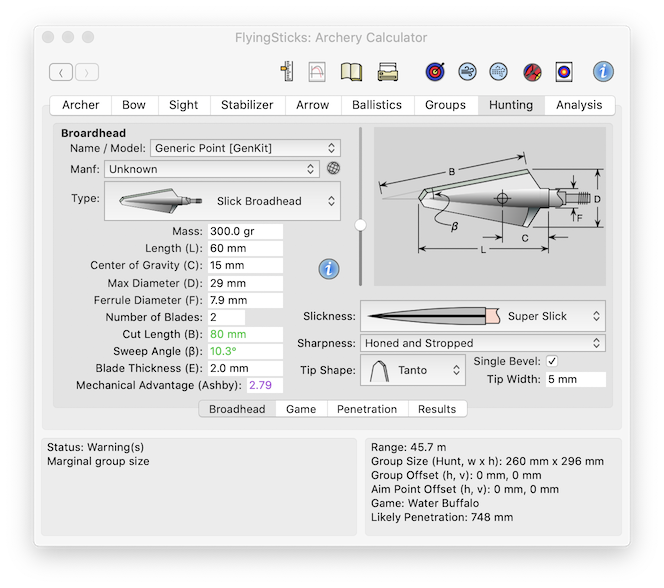Some basic point information may already have been entered in the Arrow>Point panel. This Broadhead panel allows the entry of additional data pertinent to arrow aerodynamics and penetration.

Enter the model name or identification for recording purposes.
Optionally enter or select the manufacturer's name. Same field as in Arrow>Point panel.
Select the closest broadhead from the drop-down list. Selecting a point will load a new set of defaults. So it is recommended you save the kit with current arrow, then rename the point before selecting a new type.
Enter the broadhead's mass.
This is the length from the shoulder to the tip. It is used in the aerodynamic calculations.
Enter the CoG position relative to the shoulder. There is no need to be too pedantic with this measurement, just balance the broadhead on a pencil to get an approximate (±3 mm, ±0.1") position.
For cutting points, this is effectively the Cut diameter. Some jurisdictions have a minimum in this regard. For other points it is simply the maximum diameter. Defaults to the ferrule diameter for most points.
Color changes to red if the diameter inadequate for bleed channel requirements of the current game.
Enter the ferrule diameter. Ideally this would be fractionally (~0.2 mm) larger than the shaft for hunting arrows.
Enter the number of cutting edges.
Enter the average length of the cutting edges. In the case of curved blades, use the straight line length from the cutting tip to the widest point. The cut length and the maximum diameter are used to estimate the average sweep angle and cutting efficiency. The Cut Length is automatically calculated when a Sweep angle is entered.
This is the average blade angle from the arrow's longitudinal axis. When the cutting edge is curved take a sensible average. There is no need to be too pedantic here as the sensitivity to this angle is low when less than 30°. The sweep angle is automatically calculated when a Cut Length is entered.
Enter the average blade thickness. In the case of judo and bird points it is the wire diameter.
The calculated mechanical advantage of a broadhead as per Ed Ashby. This is derived by the equation:
MA = blade_cut _length / ( blade_radius . number_of_blades)
This is a measure of the likely blade penetration efficiency, favoring blades set with acute cutting angle with a minimum number of blades.
Select the most appropriate level of "slickness". The images show the side view of various two bladed broadheads, and indicate subtle differences can have a significant impact on penetration.
Slickness is a fuzzy measure of the cleanliness of the design in moving through flesh and bone. A clean design is one that looks like a classic jet fighter - smooth, sleek and without protrusions or rough surfaces, but maybe with more sweep-back to promote cutting.
Select the appropriate edge sharpness. Needless to say, the cutting edge should be razor sharp.
Select the broadhead's tip design. While the needle is best for penetration, it is very likely it will bend on striking significant bone, statistically reducing it probability of achieving potential penetration.
Enter the width of the tip feature - typically around 5 mm. A rule of thumb is 65% of the rib thickness of the largest game likely to be encountered.
Check if the broadhead blade edges are of a single bevel. Assumes all beveled edges support spin in the same direction as the fletches.
For more discussion on broadheads, see the FlyingSticks eBooklet.